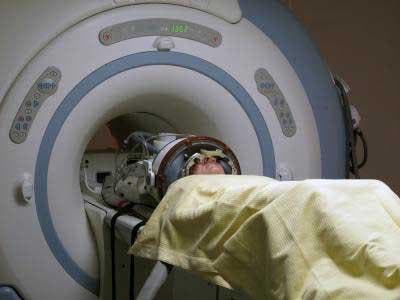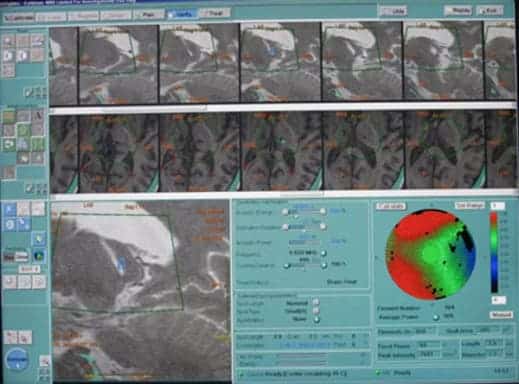A preliminary study from Switzerland, published this month in the Annals of Neurology, proved the effectiveness of a new method of non-invasive brain surgery: using a newly-developed operating device that relies on ultrasound, in conjunction with magnetic resonance imaging (MRI), allowed neurosurgeons to precisely remove small pieces of brain tissue in nine patients suffering from chronic pain without removing skin or skull bone. Researchers now plan to test it on patients with other disorders, such as Parkinson’s. Neal Kassell, neurosurgeon at the University of Virginia, not directly involved in the study.

Image via medgadget
“The groundbreaking finding here is that you can make lesions deep in the brain–through the intact skull and skin–with extreme precision and accuracy and safety,” says Neal Kassell, neurosurgeon at the University of Virginia, not directly involved in the study and chairman of the Focused Ultrasound Surgery Foundation.
High-intensity focused ultrasound (HIFU) is not the type of ultrasound used for diagnostics, or parental screening. Rather, the focused, high-intensity ultrasound beams are used to heat up and destroy pieces of diseased tissue. Currently, HIFU is used to remove small benign uterine tumors, known as fibroids, and it’s being clinically tested for removal of breast tumors and cancer tumors. Israeli company InSightec however has experimented with HIFU devices used for brain surgery, and the success of the recent Switzerland trials attest to the efficacy of the method.
When surgery feels like a hole in the head
The study involved treating nine patients suffering from acute, debilitating chronic pain that did not respond to medication, using the new technology. In such cases, the treatment is the destruction of a small piece of the thalamus, that relays messages between different brain areas. Traditionally, one of two methods can be applied to achieve this:
- Drill a hole in the skull, and insert an electrode intro the brain — a method known as radiofrequency ablation.
- Deliver a beam of focused, ionizing radiation into the targeted tissue — a method called radiosurgery.
Now, unsurprisingly, most patients choose option number 2. Kassell says that the HIFU method has several advantages over radiosurgery, as the effects of radiation on tissue can take weeks to months to manifest, whereas the thermal approach is immediate.
“The precision and accuracy [are] considerably greater with ultrasound, and it should be in principle safer in the long run,” he adds.
One downside of HIFU is that, compared to more invasive electrode neurosurgeries is that it cannot functionally test if the treated area is the correct one. With radiofrequency ablation, neurosurgeons can stimulate the cells using the electrode to verify if he or she has identified the piece of the brain responsible for the patient’s motor problems, and then destroy that piece of tissue.
“Not every functional neurosurgeon will accept this [method], because you cannot do a test before the lesion is made,” says Ferenc Jolensz, director of the Division of MRI and Image Guided Therapy Program at Brigham and Women’s Hospital in Boston.
Jolensz and collaborator Seung-Schik Yoo are currently trying to develop methods to use HIFU to modulate brain activity in a localized area, which would enable functional testing of the target area before it is destroyed. Jolensz is also studying HIFU for brain surgery and has tested the technology on four patients with brain tumors, though the results have not yet been published.
Sounds like a cure
The biggest development challenge designers had to overcome was figuring out how to focus the beams through the skull bone — its structure attenuates sound vibration and distorts their path, making the method at least ineffective, and at its worst, dangerous for the patient. InSightec’s solution was to build an array of more than 1,000 ultrasound transducers, allowing each to be individually focused.

Image technologyreview
“You take a CT scan of the patient’s head and tailor the acoustic beam to focus through the skull,” says Eyal Zadicario, head of InSightec’s neurology program.
The device also has a built-in cooling system to prevent the skull from overheating from the vibrations.
Depending on the condition being treated, the ultrasound beams are focused on specific points in the brain which absorbs the energy and converts it to heat — about 130 degrees Fahrenheit (54.5 Celsius) of heat, to be precise, killing the cells in a region of about 10 cubic millimeters around the treated point. To ensure that the right spot is being targeted, an MRI scanner is employed at the same time as the ultrasounds.
“Thermal images acquired in real time during the treatment allow the surgeon to see where and to what extent the rise in temperature is achieved,” says Zadicario.
And it works. In the study, all of the nine patients reported immediate pain relief after the procedure and needed no time to convalesce
“Two patients had a glass of Proseco [wine] with us,” says Ernst Martin, director of the Magnetic Resonance Center at the University Children’s Hospital Zurich and lead author of the study.
Apart from a feeling a few seconds of tingling or dizziness, and one reported case of a brief headache as the targeted tissue heated up, there were no side effects after the surgery.
“This will give a lot of impetus for manufacturers of focused ultrasound equipment to get interested in the brain,” says Kassell.
An experimental version of InSightec’s ultrasound device is currently being tested in five medical centers around the globe. In addition to using it with Parkinson’s patients and those who suffer other movement disorders, scientists plan to test the technology as a treatment for brain tumors, epilepsy, and stroke.
One downside of HIFU compared to the more invasive neurosurgeries performed with an electrode is that surgeons are unable to functionally test whether they have targeted the correct part of the brain. During traditional surgery for Parkinson’s, for example, the neurosurgeon stimulates the target area with the electrode to make sure he or she has identified the piece of the brain responsible for the patient’s motor problems, and then kills that piece of tissue.






